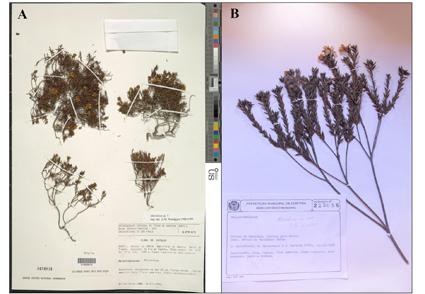Abstract
Microlicia is a Neotropical genus with about 245 species centered in central-eastern Brazil, in areas of campo rupestre and Cerrado. The majority of species occur in the states of Minas Gerais, Bahia, and Goiás. Based on specimens from the herbaria ALCB, HUEFS, MBM, SPF, HUFU, and US, we here describe two new species from the Chapada Diamantina region, Microlicia decumbens and Microlicia macaubensis. Microlicia decumbens is apparently endemic to Abaíra municipality, whereas M. macaubensis is known only from Brotas de Macaúbas municipality. We provide morphological descriptions, line drawings, a distribution map, and comparisons with putative relatives for both species.
References
Alves, R., Silva, N.G., Oliveira, J.A. & Medeiros, D. (2014) Circumscribing campo rupestre–megadiverse Brazilian rocky montane savanas. Brazilian Journal of Biology 74: 355–362. https://doi.org/10.1590/1519-6984.23212
Beentje, H. (2010) The Kew Plant Glossary an illustrated dictionary of plant terms. Royal Botanic Gardens, Kew, UK, 171 pp.
Carmo, A., Pacifico, R., Gonçales-Silva, R., Sbais, P.G., Fidanza, K. & Souza, L.A. (2019) Epidermal micromorphology and venation patterns of Microlicieae (Melastomataceae) leaves: Looking for new characters for the taxonomy of this neotropical tribe. FLORA 261: 151–494. https://doi.org/10.1016/j.flora.2019.151494
Don, D. (1823) [‘’1822’’] An illustration of the natural family of plants called Melastomataceae. Memoirs of the Wernerian Natural History Society 4: 276–329.
Fidanza, K., Martins, A.B. & Almeda, F. (2020) Lavoisiera in Flora do Brasil 2020. Jardim Botânico do Rio de Janeiro. Available from: http://floradobrasil.jbrj.gov.br/reflora/floradobrasil/FB9492 (accessed 10 December 2021)
Hickey, M. & King, C. (2000) The Cambridge Ilustrated Glossary of Botanical Terms. Cambridge University Press.
IUCN Standards and Petitions Committee (2022) Guidelines for Using the IUCN Red list Categories and Criteria. Version 15. Prepared by the Standards and Petitions Subcommittee. Available from: http://www.iucnredlist.org/documents/RedListGuidelines.pdf (accessed 9 March 2022)
Koschnitzke, C. & Martins, A.B. (2007) Nomenclatural Alterations in Microlicieae (Melastomataceae). Novon 17: 472–475.
Martius, C.F.P. von (1832) Nova Genera et Species Plantarum quas in Itinere per Brasiliam. Instituto Scientiarum Gallico 3: 1–198.
Mendoza-Cifuentes, H., Ariza, W., Granados, D.E. & Romero, R. (2019) A new species of Microlicia (Melastomataceae): first record of the genus for Colombia. PhytoKeys 122: 87–96. https://doi.org/10.3897/phytokeys.122.34171
Pacifico, R. & Almeda, F. (2018) Two new species of Microlicia (Melastomataceae) from the Cadeia do Espinhaço, Brazil. Brittonia 70: 445–454. https://doi.org/10.1007/s12228-018-9539-z
Pacifico, R. & Almeda, F. (2020) Microlicia morrensis (Melastomataceae): the third species in the genus endemic to Morro do Chapéu, Bahia, Brazil. Phytotaxa 454: 137–144. https://doi.org/10.11646/phytotaxa.454.2.5
Pacifico, R., Almeda, F., Frota, A. & Fidanza, K. (2020a) Areas of endemism on Brazilian mountaintops revealed by taxonomically verified records of Microlicieae (Melastomataceae). Phytotaxa 450: 119–148. https://doi.org/10.11646/phytotaxa.450.2.1
Pacifico, R., Almeda, F., Rodrigues, L.J.G. & Fidanza, K. (2020b) Novelties in Microlicia (Melastomataceae: Microlicieae) from the Bolivian Cerrado. Phytotaxa 433: 225–234. https://doi.org/10.11646/phytotaxa.433.3.4
Pacifico, R. & Fidanza, K. (2020) Trembleya in Flora do Brasil 2020. Jardim Botânico do Rio de Janeiro. Available from: http://floradobrasil.jbrj.gov.br/reflora/floradobrasil/FB9979 (accessed 10 December 2021)
Pataro, L., Romero, R. & Roque, N. (2013) Four new species of Microlicia (Melastomataceae) from Chapada Diamantina, Bahia, Brazil. Kew Bulletin 68: 285–293. https://doi.org/10.1007/s12225-013-9448-y
Pataro, L., Romero, R. & Roque, N. (2017) Microlicieae (Melastomataceae) from municipality Mucugê, Chapada Diamatina, Bahia, Brazil. Rodriguésia 68: 1287–1311.
QGIS Development Team (2021) QGIS Geographic Information System. Open Source Geospatial Foundation. Available from: http://qgis.org (accessed 20 December 2021)
Romero, R. & Woodgyer, E.M. (2018) Six new species of Microlicia (Melastomataceae) from Bahia, Brazil. Kew Bulletin 73: 1–16. https://doi.org/10.1007/s12225-018-9747-4
Romero, R., Fontelas, J.C., Moreira, K.V.C., Ferreira-Alves, R., Oliveira, L.F.A. & Versiane, A.F.A. (2020) Microlicia in Flora do Brasil 2020. Jardim Botânico do Rio de Janeiro. Available from: http://floradobrasil.jbrj.gov.br/reflora/floradobrasil/FB9782 (accessed 10 December 2021)
São-Mateus, W.M., Cardoso, D.B., Queiroz, L.P. & Jardim, J.G. (2016) A striking new species of Harpalyce (Leguminosae, Brongniartieae) from highland Cerrado of Bahia, Brazil. Phytotaxa 246: 120–126. https://doi.org/10.11646/phytotaxa.246.2.3
Silva, D.N., Koschnitzke, C., Jesus, J.C. & Guimarães, P.J.F. (2020) Chaetostoma in Flora do Brasil 2020. Jardim Botânico do Rio de Janeiro. Available from: http://floradobrasil.jbrj.gov.br/reflora/floradobrasil/FB9436 (accessed 10 December 2021)
Silveira, F.A.O., Negreiros, D., Barbosa, N.P.U., Buisson, E., Carmo, F.F., Carstensen, D.W., Abel, A.C., Cornelissen, T.G., Echternacht, L., Fernandes, G.W., Garcia, Q.S., Guerra, T.J., Jacobi, C.M., Lemos-Filho, J.P., Stradic, S.L., Morellato, L.P.C., Neves, F.S., Oliveira, R.S., Schaefer, C.E., Viana, P.L. & Lambers, H. (2016) Ecology and evolution of plant diversity in the endangered campo rupestre: a neglected conservation priority. Plant and soil 403: 129–152. https://doi.org/10.1007/s11104-015-2637-8
Thiers, B. (2021) [continuously updated] Index Herbariorum: A global directory of public herbaria and associated staff. New York Botanical Garden’s virtual Herbarium. Available from: http://sweetgum.nybg.org/science/ih/ (accessed 7 March 2022)
Versiane, A.F.A., Silva, D.N. & Romero, R. (2020) A new species of Microlicia (Melastomataceae) from Bolivia and Brazil, a new synonym, and an identification key for the genus in Mato Grosso, Brazil. Phytotaxa 455: 9?20. https://doi.org/10.11646/phytotaxa.455.1.2
Versiane, A.F.A. & Silva-Gonçalves, K.C. (2020) Stenodon in Flora do Brasil 2020. Jardim Botânico do Rio de Janeiro. Available from: http://floradobrasil.jbrj.gov.br/reflora/floradobrasil/FB30822 (accessed 10 December 2021)
Versiane, A.F.A., Romero, R., Reginato, M., Welker, C.A.D., Michelangeli, F.A. & Goldenberg, R. (2021) Phylogenetic analysis of Microlicieae (Melastomataceae), with emphasis on the re-circumscription of the large genus Microlicia. Botanical Journal of the Linnean Society 197: 35–60. https://doi.org/10.1093/botlinnean/boab011
Woodgyer, E.M. (2005) Multi-access key and checklist to the species of Microlicia (Melastomataceae) in Bahia, Brazil. Kew Bulletin 60: 441–448.
Woodgyer, E.M. & Zappi, D.C. (2005) Two new species of Microlicia D. Don (Melastomataceae) from Catolés, Bahia, NE Brazil. Kew Bulletin 60: 435–440.
Woodgyer, E.M. & Zappi, D.C. (2009) Two new species of Microlicia D. Don (Melastomataceae) from Bahia, NE Brazil. Kew Bulletin 64: 279. https://doi.org/10.1007/s12225-009-9121-7
Wurdack, J.J. (1983) Certamen Melastomataceis XXXVI. Phytologia 53: 121–137.
Zappi, D.C., Lucas, E., Stannard, B.L., Nic Lughadha, E., Pirani, J.R., Queiroz, L.P., Atkins, S., Hind, D.J.N., Giulietti, A.M., Harley, R.M. & Carvalho, A.M. (2003) Lista das plantas vasculares de Catolés, Chapada Diamantina, Bahia, Brasil. Boletim de Botânica 21: 345–398.


